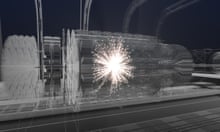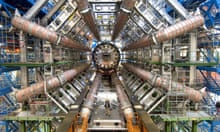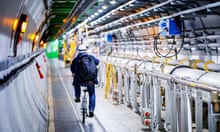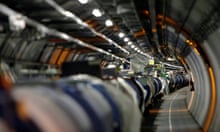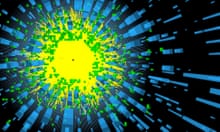Plans for a machine that would dwarf the Large Hadron Collider have been drawn up by researchers at Cern to take over the baton in the search for new physics in the latter half of the century.
The €20bn (£17.8bn) machine, named the Future Circular Collider, would smash particles together inside a 100km (62 mile) tunnel, making it four times the size of the LHC, which at present is the largest scientific instrument on the planet.
The proposal for the FCC is described in a conceptual design report released on Tuesday by Cern, the particle physics laboratory near Geneva. It comes at a time when physicists around the world are considering where to build the next cutting-edge particle collider, with other machines under discussion in Japan and China.
Fabiola Gianotti, the director general of Cern, called the latest proposal “a remarkable accomplishment”. “It shows the tremendous potential of the FCC to improve our knowledge of fundamental physics and to advance many technologies with a broad impact on society,” she said.
Under the plans, the machine would be built up in stages. At first it would collide electrons and positrons, their positive cousins. Then it would collide electrons with much heavier nuclei of lead atoms. By the late 2050s, it would slam protons together with an energy of 100 teraelectronvolts, or nearly 10 times that of the Large Hadron Collider.
The subatomic debris thrown out by the collisions could potentially give scientists the chance to study the Higgs particle with unprecedented precision, and create new particles that have so far evaded observation.
Peter Higgs predicted the existence of what became known as the Higgs boson in 1964. But the mysterious particle which confers mass on the building blocks of matter was not discovered until 2012 when physicists spotted the telltale signs of its creation in the LHC. The discovery led to the Nobel prize for Peter Higgs the following year.
Plans for the FCC, along with other proposals, will now go forward to an international panel of scientists who will consider them as part of a new European strategy for particle physics which is due to be published in 2020.
There is no guarantee the machine will be built. In 1993, the US scrapped the construction of the Superconducting Super Collider, a machine somewhat smaller than the FCC, after spending $2bn (£1.5bn) on the machine. In December, plans to build a $7bn International Linear Collider in Japan ran into trouble when an influential science committee concluded the cost was too high.
Brian Foster, professor of experimental physics at Oxford University, said that the FCC would be unlikely to suffer the same fate as the Superconducting Super Collider. “If the money can be found credibly to start the project, then I am convinced that Cern would build it successfully,” he said.
“Ideally an FCC-like project would be a catalyst to found a true world laboratory, which is the obvious next step. After all, Cern is now clearly unofficially the world’s particle physics lab,” Foster added. “This wouldn’t mean that Asian countries or the US would cease to have their own regional programmes: the majority of US physicists are already involved in the LHC.”

